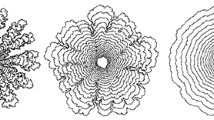Abstract
A model for the growth of populations of Saccharomyces cerevisiae is formulated and analysed. The probability of bud emergence is assumed to depend on the size of the cell. Under certain conditions on birth size the model can be reduced to a single renewal equation. Using Laplace transform techniques and renewal theory we establish the existence of a stable scar and size distribution under certain conditions on the growth rate of individual cells. The steady state values for the relative frequencies of unbudded and budded cells in the various scar classes are given.
Similar content being viewed by others
References
Adams, J., Rothman, E.D., Beran, K.: The age structure of populations of Saccharomyces cerevisiae. Math. Biosci. 53, 249–263 (1981)
Bellman, R., Cooke, K. L.: Differential-difference equations. Academic Press, New York-London (1963)
Beran, K.: Budding of yeast cells, their scars and ageing. Advan. Microb. Physiol. 2, 143–171 (1968)
Beran, K., Streiblova, E., Lieblova, J.: On the concept of the population of the yeast Saccharomyces cerevisiae. In: Kochova-Kratochivilova, A. (ed.). Proceedings of the Second Symposium on Yeasts. Publ. House Slovak. Acad. Sci. Bratislava, 353–363 (1969)
Diekmann, O.: The dynamics of structured populations: Some examples. In: Capasso, V., Grosso, E., Paveri-Fontana, S. L. (eds.). Mathematics in biology and medicine. Proceedings, Bari, 1983. Springer Lecture Notes Biomath. 57, 7–18 (1985)
Diekmann, O., Heijmans, H. J. A. M., Thieme, H.: On the stability of the cell size distribution. J. Math. Biol. 19, 227–248 (1984)
Feller, W.: On the integral equation of renewal theory. Ann. Math. Statist. 12, 243–267 (1941)
Feller, W.: An introduction to probability theory and its applications, vol. II, 2nd edn. Wiley, New York-London-Sydney-Toronto (1971)
Fink, A. M.: Almost periodic functions. Springer Lect. Notes Math. 377. Springer, Berlin-Heidelberg-New York (1974)
Gani, J., Saunders, I. W.: Fitting a model to the growth of yeast colonies. Biometrics 33, 113–120 (1977)
Gurtin, M. E., MacCamy, R. C.: Population dynamics with age dependence, in non-linear analysis and Mechanics: Heriot-Watt Symposium, vol. III. Knops, R. J. (ed.). Pitman, San Francisco, T-35 (1979)
Gyllenberg, M.: The age structure of populations of cells reproducing by asymmetric division. In: Capasso, V., Grosso, E., Paveri-Fontana, S. L. (eds.). Mathematics in biology and medicine. Proceedings, Bari, 1983. Springer Lect. Notes Biomath. 57, 320–327 (1985)
Gyllenberg, M., Heijmans, H. J. A. M.: An abstract delay-differential equation modelling size dependent cell growth and division. Preprint (1985)
Hamada, T., Kanno, S., Kano, E.: Stationary stage structure of yeast population with stage dependent generation time. J. Theor. Biol. 97, 393–414 (1982)
Hamada, T., Nakamura, Y.: On the oscillatory transient stage structure of yeast population. J. Theor. Bil. 99, 797–805 (1982)
Hartwell, L. H., Unger, M. W.: Unequal division in Saccharomyces cerevisiae and its implications for the control of cell division. J. Cell. Biol. 75, 422–435 (1977)
Hjortso, M. A., Bailey, J. E.: Steady-state growth of budding yeast populations in well-mixed continuous flow microbial reactors. Math. Biosci. 60, 235–263 (1982)
Hjortso, M. A., Bailey, J. E.: Transient responses of budding yeast populations. Math. Biosci. 63, 121–148 (1983)
Hoppensteadt, F.: Mathematical theories of populations: demographics, genetics and epidemics. SIAM, Philadelphia, Pennsylvania (1975)
Johnston, G. C., Pringle, J. R., Hartwell, L. H.: Coordination of growth with cell division in the yeast Saccharomyces cerevisiae. Exp. Cell Res. 105, 79–98 (1977)
Lord, P. G., Wheals, A. E.: Asymmetrical division of Saccharomyces cerevisiae. J. Bacteriol. 142, 808–818 (1980)
Lord, P. G., Wheals, A. E.: Variability in individual cell cycles of Saccharomyces cerevisiae. J. Cell. Sci. 50, 361–376 (1981)
Markushevich, A. I.: Theory of functions of a complex variable, vol. 2 (English translation). Prentice-Hall Inc., Englewood Cliffs, N.J. (1965)
Metz, J. A. J., Diekmann, O.: Dynamics of physiologically structured populations. Springer Lect. Notes Biomath. (to appear)
Mortimer, R. K., Johnston, J. R.: Life span of individual yeast cells. Nature 183, 1751–1752 (1959)
Tuljapurkar, S. D.: Transient dynamics of yeast populations. Math. Biosci. 64, 157–168 (1983)
Author information
Authors and Affiliations
Rights and permissions
About this article
Cite this article
Gyllenberg, M. The size and scar distributions of the yeast Saccharomyces cerevisiae . J. Math. Biology 24, 81–101 (1986). https://doi.org/10.1007/BF00275722
Received:
Revised:
Issue Date:
DOI: https://doi.org/10.1007/BF00275722




